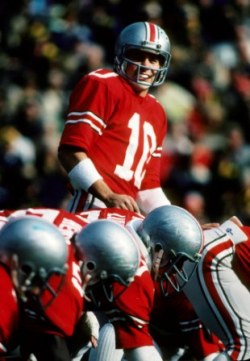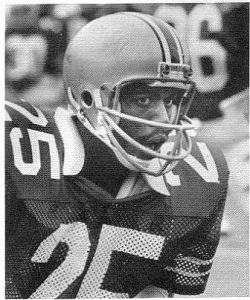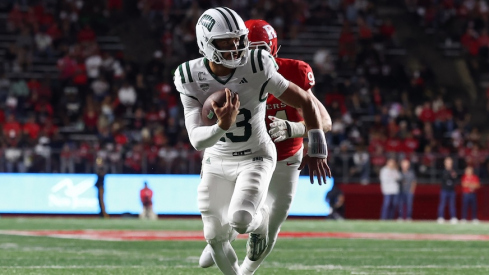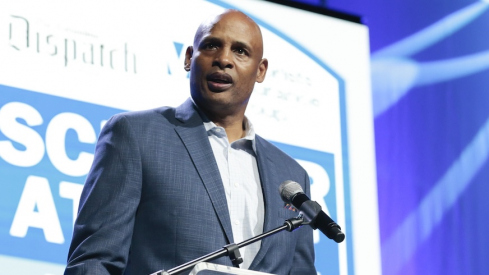Ohio State entered the 1980 season ranked #1 in the pre-season polls, by virtue of their 11-0 regular season and close loss to USC in the Rose Bowl. Everyone thought highly of the team, and the face of junior quarterback Art Schlichter graced the cover of most of the college football preview magazines. However, the team had some key weaknesses that would be exploited by opponents from time to time throughout the season.
 Schlichter was the pre-season cover boy in 1980.
Schlichter was the pre-season cover boy in 1980.Not many fans or prognosticators made note of it, but Ohio State lost 4 of their 5 starting offensive linemen from the previous season. The one remaining starter, tackle Joe Lukens, was shifted to guard and the tackle positions were filled by players moving from other positions: left tackle Luther Henson moved from defensive tackle and right tackle Ron Barwig moved from tight end (sound familiar?).
Another position depleted by losses was fullback, where rotating starters Paul Campbell and Ric Volley departed. Sophomore tailback Tim Spencer was moved to fullback even though he was undersized for the position at 215 pounds. New starting center Jim Deleone was also undersized for the position, adding to the uncertainty along the front wall.
Nevertheless, the return of their All-American QB from the previous season, along with all of his receivers, and the return of 1,000-yard rusher Calvin Murray left observers optimistic about the offense. It was thought that the defense was more solid with 9 starters returning. But there were some problems in that area that did not show up on paper but made themselves manifest on the field.
In the opener against Syracuse, new starting noseguard Mark Sullivan was being disciplined by coach Earle Bruce, and so he did not start the game. His replacement was unable to hold the middle, and as a result the Orangemen (their nickname at the time) rolled out to a 21-9 halftime lead behind the running of tailback Joe Morris.
Sullivan was inserted back into the lineup after Syracuse went up 21-3 and the defense shut them out the rest of the day. Schlichter and the offense got back on track in the second half and the team eventually cruised to a 31-21 victory, but the warning signs were showing that there might be more trouble ahead when they got into the meat of their schedule.
The trouble came into Columbus in game 4 in the form of the UCLA Bruins. Ohio State had forged a dramatic comeback victory at UCLA the previous season, and so the Bruin players were anxious to return the favor. They dominated the line of scrimmage on both sides of the ball, thus exposing OSU's lack of size and experience on offense and their lack of depth on the defensive line. UCLA led only 3-0 at halftime, but they scored on their first two possessions in the second half and shut down the Buckeye offense the rest of the way on their way to a 17-0 win.
After that, the Buckeyes regrouped and seemed to get the offense straightened out. They first went to Evanston and crushed Northwestern, 63-0, gaining 575 yards in the process. Then they came home and racked up another 499 yards in a 27-17 win over Indiana. After slogging through a 21-0 victory at Wisconsin in frigid, snowy conditions, they traveled to East Lansing and dominated Michigan State, 48-16, behind 603 yards of offense. It certainly looked like OSU had solved their offensive problems, but the defense, a strength up to this point, was about to be severely tested.
Up to this point, the Buckeyes led the Big Ten in passing defense, giving up an average of just over 100 yards per game. But coming to town in game 9 was Illinois and their prolific passing attack. Mike White had taken over as head coach of the Illini after 3 disastrous years under former OSU player and Michigan assistant coach Gary Moeller. White had been national coach of the year in 1975 at California, and had served on the staff of the San Francisco 49ers for two years before taking the job at Illinois. He brought to the team a sophisticated passing attack led by junior college transfer Dave Wilson.
Wilson was a quarterback who threw the ball hard and with great accuracy. His skills were tailor-made for White's short passing game. Looking at the film of the OSU defense, and surveying his team's depleted corps of running backs, White decided he had no choice but to air it out against Ohio State. He told his players before the game to expect that they would throw 60-70 passes in the game. The way the game started, he would end up being forced to pass often in any event just to keep up with the OSU offense.
 Todd Bell and the secondary were burned by Wilson.
Todd Bell and the secondary were burned by Wilson.Behind the passing of Schlichter, the Buckeyes scored early and often on their way to a 28-0 lead. But with just over a minute remaining in the first half, Wilson connected with receiver Greg Dentino for a 24-yard touchdown pass to cut the lead to 28-7 at halftime. But OSU was not about to let up in the second half.
Beginning the 3rd quarter with the ball, the Buckeyes moved quickly down the field and Schlichter hit receiver Doug Donley with a 26-yard TD pass to increase their lead to 35-7. At this point, White decided that running was futile and he decided to throw on every play. They got the ball back and moved down the field swiftly, scoring on a 38-yard pass from Wilson to tight end Lee Boeke to cut the lead to 35-14.
In those days, it was not expected that teams could come back from so large of a deficit, and so Ohio State attempted to kill the clock with the running game and played a variation of a "prevent" defense to try to keep Illinois from scoring quickly. Neither was very effective on this day. OSU's Murray fumbled on their next possession, and the Illini quickly took advantage with another passing TD to cut the lead to 35-21.
After a forced punt, Illinois once again moved down the field in only 7 plays to score another TD on a 13-yard pass. Now it was 35-28 and OSU fans were getting restless. Illinois forced a punt on the next possession, but Dentino fumbled it away and the Buckeyes were in business. They scored quickly to up the lead to 42-28, but Wilson and the Illini were far from finished. He led them on an 83-yard march that culminated in a 2-yard scoring pass to running back Greg Foster that made the score 42-35.
Ohio State finally got a long, time-consuming 72-yard drive for a touchdown when Spencer scored from the 2 to increase the lead to 49-35, but there was still almost 11 minutes remaining in the game. On their next possession, Wilson connected with receiver Mike Martin on a 62-yard pass, but Martin fumbled on the play and OSU cornerback Ray Ellis recovered to stop the drive. Wilson drove them down deep into OSU territory on the next possession, but Buckeye safety Vince Skillings intercepted him in the end zone to end that threat. The Illini scored one more touchdown with 11 seconds left in the game, but it was too little and too late as Ohio State held on for a 49-42 victory.
Even with the win, the carnage wrought on the Ohio State defense was staggering. Wilson finished the day 43/69 passing for an NCAA record 621 yards and 6 touchdowns. The Illini had 659 total yards, although they helped the Buckeyes out with 7 turnovers. By comparison, Schlichter's 17/21 for 284 yards and 4 TDs looked like a weak effort. Ohio State would finish the season with losses against Michigan and Penn State (in the Fiesta Bowl) to go 9-3, the first of six straight seasons with that record.
White would coach for 7 more seasons at Illinois, leading them to more success than they had enjoyed for some time. In 1983, his Illini team would go 9-0 in Big Ten play, winning the conference championship outright and earning a trip to the Rose Bowl. Overall, White finished with a record of 47-41-3 at Illinois and led the team to three bowl games. He was named national coach of the year in 1983, but was eventually fired after the 1987 season when his team went 3-7-1 and finished 8th in the Big Ten. He would eventually become the head coach of the Oakland Raiders for two seasons before being fired there as well.
Wilson would finish the season with 245 completions on 463 attempts for 3,154 yards and 19 TDs. He would ultimately play for 8 seasons in the NFL, all with the New Orleans Saints, completing 551/1039 for 6,987 yards and 36 TDs against 55 interceptions. His NCAA passing record would stand only until 1988, where it was exceeded by Scott Mitchell of Utah.

